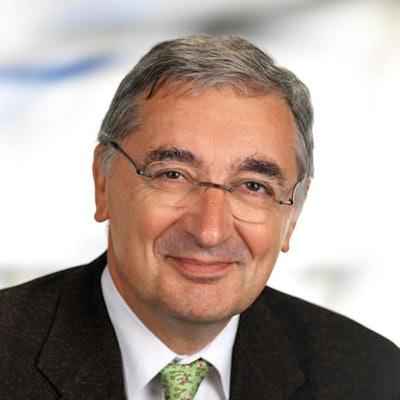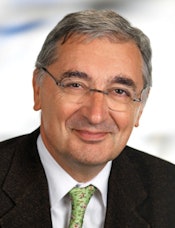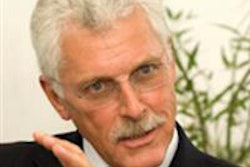
With Dr. Yves Menu at the helm of European Radiology, you can expect speedier decisions on article submissions. Since he teamed up with Dr. Maximilian Reiser, the outgoing editor in chief, to ease the handover of the role, the time between submission and first decision already has sunk to 25 days.
In June, European Radiology announced Menu as its new editor in chief. Since September, he and Reiser have worked together to aid the switch. Looking ahead to 2018, his other key plans center on timeliness, professionalism, transparency, and ethics.
 Dr. Yves Menu.
Dr. Yves Menu."Timeliness is a major comment or complaint about publication," Menu noted. "European Radiology is no exception here ... my commitment will be that the average delay between submission and first decision remains below 30 days for 95% of manuscripts."
The previous time for submission to first decision hovered around 40 to 45 days. He has used the principle of Lean 6 Sigma to analyze waste and then eliminated that waste, he wrote in an email to AuntMinnieEurope.com.
"Another waste was to send out for review manuscripts that had no chance to be accepted, either because the topic was beyond the scope of the journal, or, more commonly, because the preparation of the manuscript was suboptimal," he wrote. "Many of them have been rejected within a couple of days, without review, however, invited to resubmit if there was a potentially relevant scientific message."
If a potentially relevant scientific message existed, the reviewer gave suggestions for improvement.
"We see that authors do appreciate that, as many come back quite rapidly with an immensely improved manuscript," he wrote.
The journal expected approximately 2,300 submissions in 2017 and rejected around 1,800.
Transparency also on the docket
Related to timeliness, another goal for Menu is transparency. Revision turnaround time often lagged due to revisions. The new rule is one revision, sometimes two, returned by the authors within 45 days, followed by final editing. This means a higher number of manuscripts will be rejected with an invitation, and even encouragement, to resubmit. Often the resubmission is all it takes for acceptance, something that may be guided by the reviewers.
As part of the transparency efforts, Menu wants to utilize anonymized communication through the journal's website.
"Sometimes, the authors feel the reviewer has misunderstood his message," he wrote. "Disappointment after a rejection is understandable; however, I ask the authors to realize that if a reviewer did not understand correctly his message, maybe -- I should say certainly -- many readers would do so as well. Therefore, instead of complaining, authors are instructed to revise their presentation of the results, and they are given the possibility to start a communication, through anonymized messages, with the reviewers."
Often, authors are quick with their revisions or resubmissions -- taking days and not months. As a result, a number of manuscripts are accepted and sent to production within a time frame of eight weeks from submission, including first review, revision (sometimes major revision), second review, and final editing, according to Menu.
For manuscripts that need a quick release, European Radiology also has a fast-track review. For some manuscripts with an important and original scientific message, authors may request a fast-track review in a specific cover letter, and editors will comply if they agree. Already, the journal had two fast-tracked manuscripts.
"I also realize cutting-edge science may be sometimes difficult to understand for some of our readers who are not familiar with physics or advanced computing, for instance," Menu wrote. "We make a lot of efforts in helping the authors to reformulate their message; however, there are limits to simplification. For this reason, we are launching editorial comments, short papers (1,000 words) written by senior colleagues and explaining clearly why such a manuscript is important and represents a true advance in knowledge."
In January, the journal will launch a survey for authors, asking how satisfied they are with the editorial process -- and not just authors of accepted manuscripts. All will be invited to participate, with results available publically.
Staying ethical and professional
In a recent editorial (European Radiology, 13 November), Menu also highlighted ethics and noted that any conflicts of interest that authors, reviewers, or even editors have will be disclosed.
"Intellectual property for authors and reviewers should be guaranteed," he wrote. "We do not want ghost or honorary authorships. There should be no plagiarism, no duplication of publication. Multiple publications with the same cohort should be announced and clarified by authors. We now have tools at our disposal that help us detect these various problematic and potentially unethical situations, which fortunately are the exception in our environment."
Menu focused on professionalism as well.
"The joint venture between the European Society of Radiology (ESR), the editor, and Springer Nature, our publisher, is a win-win situation in this regard, combining complementary expertise and capabilities."
He added that without the commitment of reviewers, there would be no valuable scientific journal.
"I admire those who accept invitations to review the manuscripts," he wrote. "It is time-consuming, while our institutions constantly increase the pressure on productivity. It requires a high level of scientific knowledge, all the while remaining anonymous."
To facilitate the process, Menu will propose templates and recommendations to make the task easier.
"It is an incredible honor, as well as a challenge, to take over the position of editor in chief of European Radiology from Dr. Maximilian Reiser, who has elevated the scientific level of the journal, encouraging authors and reviewers to delve deep into the fundamentals of research while still keeping it accessible," he added.



















